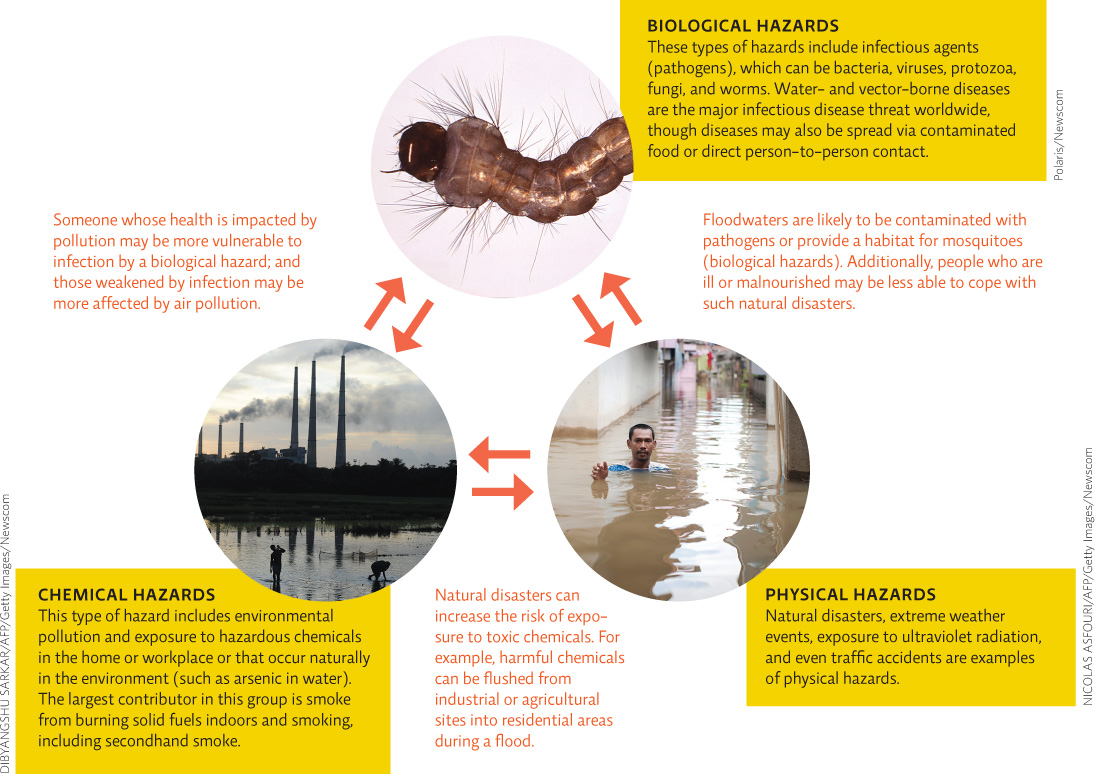Human manipulation of the environment can increase our exposure to pathogens.
Worldwide, people face a variety of health hazards. One of the biggest influences on the seriousness of any given hazard is the health of the natural environment, something we’ve had unprecedented influence over in recent centuries. “We humans have been remarkably effective at rearranging the natural world to meet our own needs,” says Sam Myers, a scientist at the Harvard University School of Public Health, in a recent article in Annual Review of Environment and Resources. In the article, he says that between one-third and one-half of global resources produced by ecosystem functions are now diverted to human uses. In the past 300 years alone, we have completely deforested between 7 and 11 million square kilometers (2.7–4.2 million square miles) of land—an area the size of the continental United States—and converted some 40% of the planet’s ice-free land surface to cropland or pasture. We have converted an additional 2 million square kilometers (0.8 million square miles) of forest into highly managed plantations with significantly less biodiversity. We are already using roughly half of the planet’s accessible surface freshwater and fishing three-quarters of monitored fisheries at or beyond their sustainable limits. And with population rising, these numbers are only likely to increase.
“We humans have been remarkably effective at rearranging the natural world to meet our own needs.”
—Sam Myers
Though this type of manipulation has made life better for many, Myers and others worry that by so dramatically altering the ecosystems around us, we have not only imperiled our access to some of the most basic components of human health—namely adequate nutrition, safe water, and clean air—but have also increased our exposure and vulnerability to both natural disasters (see LaunchPad Chapter 28: Forest Resources) and infectious diseases.
In the northeastern United States, for example, a cascade of interrelated environmental changes have helped drive the incidence of Lyme disease upward. Habitat fragmentation (a consequence of land development) has increased the edge habitats where field mice thrive. The mice are the main host reservoir for the bacterium that causes Lyme disease: It thrives in them and can be passed from host to host via ticks that bite the mice and then bite other animls. Biodiversity loss has also played a role. Unlike field mice, squirrels and possums are usually able to kill and remove the ticks before becoming infected. As biodiversity decreases, and populations of these less vulnerable hosts diminish, the ticks increasingly end up on the mice that more readily transmit the disease, building the infected tick population and increasing the chance that one will bite a person and transmit the disease.
Meanwhile, in the Amazon basin, deforestation has increased the breeding habitat for mosquitoes that transmit malaria. In Cameroon, it has altered aquatic habitats in ways that favor a schistosomiasis-carrying snail. In Asia and South America, monsoon rains and agricultural runoff have conspired to alter the salt and nutrient levels of coastal waters in ways that favor cholera population explosions. Floods that washed away latrines, emptying sewage into nearby waters, also sparked a 2012 cholera outbreak in Malawi.
Throughout the developing world, both dam building and urbanization have increased the incidence of a wide range of waterborne pathogens, including but not limited to GWD. In cities, not only do people live in much closer quarters, but an infinite variety of humanmade objects—namely old tires and discarded plastic food containers—find second life as vessels for rainwater that collects during wet seasons, bakes in sunlight, and grows dank and stagnant over time. This water provides an excellent habitat for a whole suite of vectors that transmit a host of diseases: mosquitoes that carry the dengue virus and the Plasmodium protozoan that causes malaria, black flies and snails that carry worms that cause debilitating diseases like elephantiasis, river blindness (onchocerciasis), and schistosomiasis. Dams—especially those in tropical regions—do something similar: They create large bodies of standing water that have been associated with an uptick in the same cadre of diseases.
KEY CONCEPT 5.2
Environmental hazards can be biological, chemical, or physical in nature, and any given hazard can interact with others, making these hazards more difficult to address.
In general, these hazards can be divided into three broad categories: physical hazards (see Chapter 2), chemical hazards (see Chapter 3), and biological hazards (the focus of this chapter). Biological hazard typically refers to infectious diseases—illnesses caused by an invading pathogen such as a bacterium, virus, or parasite. However, as illustrated above, we are never exposed to any hazard—be it physical, chemical, or biological—in isolation. Rather, different types of hazards interact with one another and with other elements of the human environment in ways that can make it tricky for health-care workers to map cause-and-effect relationships. For example, someone negatively affected by a chemical hazard such as air pollution may be more susceptible to a biological hazard such as a lung infection. INFOGRAPHIC 5.1
The WHO recognizes that modifiable environmental factors contribute significantly to disease, injury, and death worldwide. Environmental hazard categories can be broken down in a variety of ways, but here is one simple breakdown: physical, chemical, and biological hazards. All of these hazards can interact, sometimes in unpredictable ways, which increases the complexity of public health issues. Of these three groups, biological hazards remain the major risk in low-income nations, the areas where death rates are the highest.

Polaris/Newscom
DIBYANGSHU SARKAR/AFP/Getty Images/Newscom
NICOLAS ASFOURI/AFP/Getty Images/Newscom

How might biological and chemical hazards be affected during a natural disaster such as a flood?
The flood could provide habitat for mosquito vectors or could overwhelm sanitation systems, allowing the release of untreated sewage into environmental waters. It could also wash more chemical hazards off of land surfaces (roads, farms) or out of flooded facilities (factories or storage areas in farms or businesses).